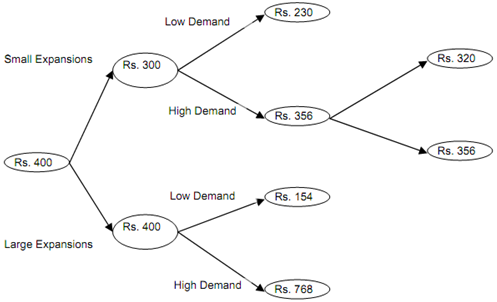Simulation:
Complex waiting line problems should be analyzed with simulation. It discovers the blockage or bottleneck of the process and appropriate capacity cushions, even for complicated processes with random demand patterns with predictable rushes in demand during a typical day.
Decision Trees
Decision tree is utilized particularly for evaluating different capacity expansion alternatives when the demand is uncertain and sequential decisions are involved. For instance, the owner of a restaurant can expand the restaurant now, only to discover in 4 years that demand growth is much higher than forecasted. In that case, the owner ought to decide whether to expand further or not. In terms of construction costs and down time, expanding twice is likely to be much more costly than building a large facility from the start. Though, making a large expansion now while demand growth is low means poor facility utilization.
Figure illustrates a decision tree for this view of the problem, with new information provided. The demand may be either low or high, with probabilities of 0.4 and 0.6, respectively. The initial expansion in year 1 may either be small or large. The second decision node, whether to expand at a later date, is attained only if the initial expansion is small and demand turns out to be high. If demand is high and if the initial expansion is small, a decision should be made about a second expansion in year 4. Payoffs for each branch of the tree are estimated. For instance, if the initial expansion is large, the financial benefit is either Rs.154,000 or Rs. 768,000, based on whether demand is low or high. Weighting these payoffs by the probabilities yields an expected value of Rs. 400,000. This expected payoff is higher than Rs. 300,000 payoff for small preliminary expansion, so the best choice is to make a large expansion in year 1.

Figure: A Decision Tree for Capacity Expansion